Difference between Potentiometer and Rheostat – The main difference between a potentiometer and a rheostat is their function related to the parameters of the circuit. While a potentiometer is employed to detect the unknown EMF (Electro Magnetic Field) and control the voltage of a circuit, a rheostat is used to monitor the flow of current within a circuit. The potentiometer determines the EMF for voltage by using a comparison with a specified voltage. On the other hand, the rheostat detects the flow of current in the system by modifying the resistance.
A potentiometer is a three-terminal device for controlling voltage, whereas a rheostat is a two-terminal device for controlling current. In electrical systems, Potentiometers and rheostats are essential components. Potentiometer and Rheostat are available from a variety of Suppliers And Companies, as well as a variety of manufacturers and distributors, and there are many Potentiometer and Rheostat For Sale on Linquip.
There is a comprehensive list of potentiometer and rheostat services on the Linquip website that covers all of your needs. Linquip suppliers can assist you with this. Please contact Linquip’s Potentiometer and Rheostat Experts to learn more about how to connect with a diverse group of service providers who consistently deliver high-quality products.
You can see a comparison chart between Potentiometer and Rheostat at what follows:
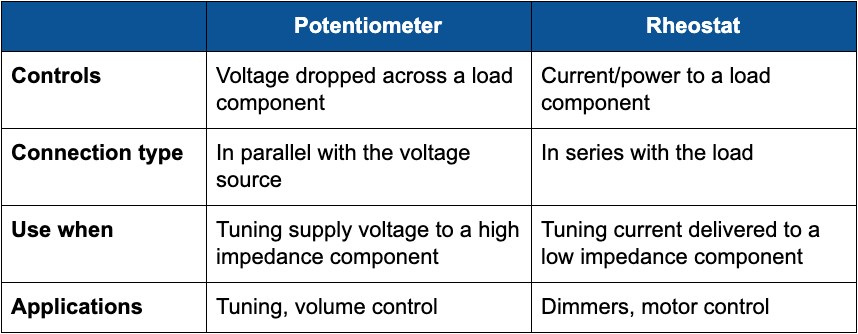
Introduction to Variable Resistor (VR)
Rheostats and Potentiometers are two instruments that are introduced as the variable resistors. Both of them provide the two different arrangements presented technically by the same sections. After reading this post, you can distinguish both types clearly.
A variable resistor is a device with a three-terminal configuration. It presents a variable amount of resistance within the electrical circuits. For instance, a 15 kΩ V.R will represent a resistance value between 0 to 15k. The most usual type of VRs is illustrated below. It includes three terminals a, b, c. The particular knob can be circulated to obtain a modification in output resistance.
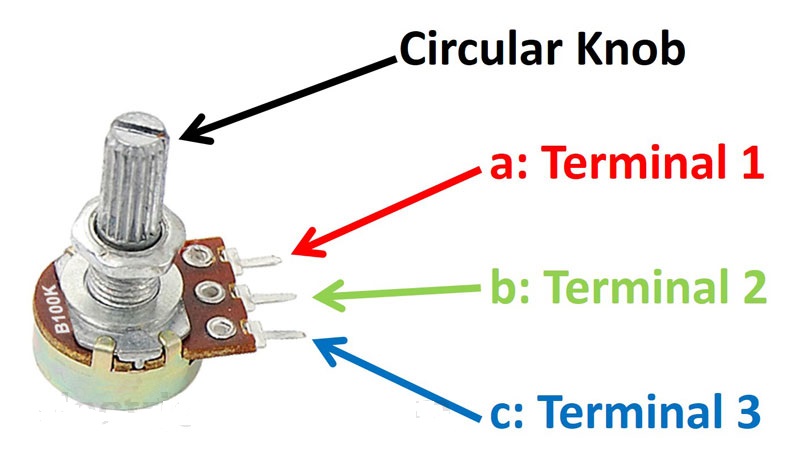
As previously discussed, the above form of variable resistors is the most usable. Meanwhile, it is the oldest type too. Modern variable resistors are provided as trimpots including a small bolt in their package. A tightener screw can be employed with these trimpots for particular applications.
We will present different features that determine the difference between potentiometer and rheostat in this post. The operating and circuit symbols of rheostat and potentiometer are also discussed. The forms of potentiometers utilized, and their applications are also presented in this post. Rheostat vs. Potentiometer application is also provided especially.
What Is a Potentiometer?
A potentiometer is a variable resistor usually known as POT that is manually adjustable including three terminals. Two terminals are attached to both sides of a resistive instrument, and the third terminal combines with a movement section known as a wiper, sliding near the resistive element. The voltage of the potentiometer is specified by the location of the wiper. The potentiometer generally performs as a variable signal divider. The resistive section can be presented as two resistors in a series arrangement where the wiper placement controls the resistance rate of the first resistor to the next one.
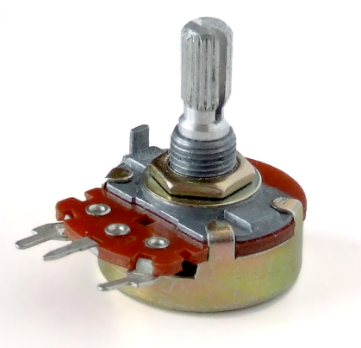
A potentiometer does not need an additional power source for the operation. While using a potentiometer in the system, its terminals are also connected to the circuit. The wiper creates a connection with the system that sends the output voltage within that circuit. The amount of this output will change based on the voltage rates of the two terminal standpoints.
A potentiometer works as a voltage separator whose output voltage presents the modification of the movement of the slider in the system. The next figure demonstrates the arrangement of the terminals of a potentiometer and its circuit:
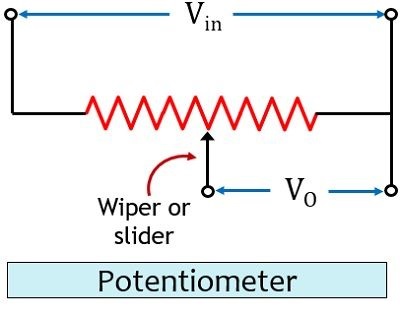
A potentiometer is employed to determine the electro motive force EMF of a particular cell in the circuit, the specified resistance of the system, and comparing the emf of various cells. It is also applied as a variable instrument in multiple applications.
Resistors typically present a constant amount of resistance that resists or blocks the flow of electrical current within the circuit and generating a voltage reduction based on Ohm’s law. Resistors can be constructed to have a constant resistive amount by some external changes.
Two common types of potentiometers can be manually adjustable including Logarithmic potentiometer in which a particular part transfers around a circular section, and Linear potentiometer in which the wiper goes and backs linearly.
Logarithmic Potentiometer
This form of POTs is normally introduced with the “A” sign in the instrument. For instance, a POT with 4kΩ resistance will be known as “4k A”. The main substance of this instrument is a resistive structure that may be attached from one section to the other. It may also be a substance whose resistivity modifies from one part to the other. This kind of POT has a logarithmic value. They are often employed in audio circuits according to this nature. They are more expensive than other kinds of potentiometers.
Linear Potentiometer
This kind of POTs is normally signed with the letter “B” in the device. For example, a POT with 10kΩ resistance will be introduced as “10k B”. In this instrument, the main element has a fixed cross-section causing a resistance variation between the wiper part and one section of the terminal. This instrument is based on the electrical factor and not the resistive characteristic. This type of potentiometer is employed for proportional variations like regulating the center part of a CRO.
What You Need to Know About Potentiometer?
- A potentiometer is a type of resistors including three terminals and a movement section to contact with a particular voltage separator.
- A potentiometer is employed as a detector component in electronics.
- A potentiometer is constructed of resistive parts including resistance wire, graphite, cermet, and carbon components.
- A potentiometer is typically used in systems to change the voltage or to provide a variable voltage source. So, the fundamental performance of a potentiometer is to modify the voltage.
- A potentiometer uses power in the low situation and is employed for television control, audio systems, and as a transducer.
- The potentiometer is arranged in a parallel form with other parts of a circuit.
- A potentiometer can be utilized as a rheostat because a rheostat cannot control the amount of voltage.
Application of Potentiometer
There are different applications for a potentiometer. The three common applications of a potentiometer are:
- Detecting the voltage through a branch of a diagram.
- Detecting the internal resistance value of a battery.
- Comparing a battery EMF of a particular cell with a normal cell.
What Is a Rheostat?
A rheostat is a common type of variable resistors that is employed to monitor the flow of current by raising or reducing the resistance manually. It can modify the resistance in a system without interruption. Rheostats are usually utilized as power control instruments to monitor the speed of motors, the intensity of light, heaters, and also ovens. Although, according to their comparatively low efficiency and advancements in technologies, they are no longer utilized for these procedures anymore. They are generally employed for calibration and tuning in systems.
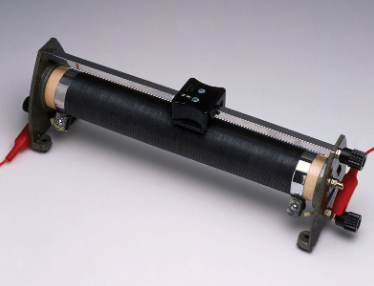
This is a two-terminal device that detects the amount of current flowing within the system. One section is straightly attached to the circuit while the other side is unconnected. The wiper terminal creates the relation with the circuit like the potentiometer.
You know that the current flow in any circuit is based on the value of resistance and voltage. So, when the resistance of the circuit is modified, then the current flow also provides variation. This is the operation principle of the rheostat. The next diagram presents the configuration of a rheostat:
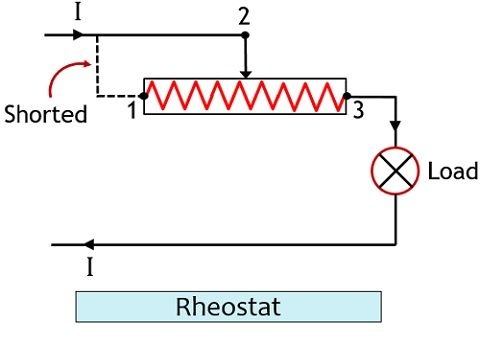
The wiper terminal occasionally makes a junction with terminal one and produces a short-circuiting area between terminals one and two. The operation principle of rheostat can be simply introduced as a relation between the resistance of any part with its length in which the current is moving.
If you change the slider position in a place from the attached terminal, the length of the resistive material increases. So, the resistance will be increased too. If the section is moved in the next terminal, then this immediately decreases the resistive area length causing the reduction of the resistance.
It should be considered here that regardless of the actual resistance variation, the slider movement is varying the resistive length of that section. This can increase or reduce the resistance value and therefore the amount of current.
The construction process of a rheostat is generally like a potentiometer. A rheostat has two different connections; the first one is attached to the end of the resistive area and the other one is holding the sliding contact.
Can You Use a Rheostat Instead of a Potentiometer?
A rheostat is a two-terminal variable resistor, whereas a potentiometer is a three-terminal variable resistor. A rheostat may be used as a potentiometer, but a potentiometer cannot be used as a rheostat. Rheostats are used to control current while potentiometers are used to control voltage. For low-power applications, a potentiometer is usually preferred. In high-power sectors, a rheostat is often utilized. Within the system, the potentiometer is set up in parallel, while a rheostat is configured in serial, allowing the current to be easily calculated.
Rheostat Types
There are three common Rheostat types, that is:
Linear Rheostat
Linear rheostats are generally utilized in laboratories for teaching and research. The slider or wiper moves linearly in this kind of rheostat.
Rotary Rheostat
The resistive part is angle or circular and the slider or wiper moves in a rotary way in this form of a rheostat.
Preset Rheostat
Preset Rheostat is commonly used in the board of printed circuits.
What You Need to Know About Rheostat?
- A rheostat is a type of variable resistors with a two-terminal arrangement that creates a connection with one side and the slider or wiper only.
- A rheostat is utilized to modify the resistance of a diagram.
- A rheostat is constructed from different materials like fluids, carbon disk, and metal ribbon.
- A rheostat is generally used in circuits to change the current flow. Therefore, the basic function of rheostat is to monitor the flow of current.
- A rheostat is employed in high power industries and applications including fans, mixers, and motors of large industrial devices.
- Rheostat creates a series connection in the system, so the flowing current can be determined.
- A rheostat cannot be employed as a potentiometer when you need to divide voltage.
Applications of Rheostat
- They can be used to reduce or increase the speed of an electric motor or the volume of a radio.
- They are also utilized in systems or applications where a high value of voltage is needed.
- Rheostats are employed in dimmer systems to modify the intensity of light.
Differences Between Potentiometer and Rheostat
You should know about these two terms completely, before exploring the difference between potentiometer and rheostat. The term potentiometer is generally utilized to provide a three-terminal resistor section. The potentiometer and rheostat supply two dissimilar configurations in which a variable setup can be employed.
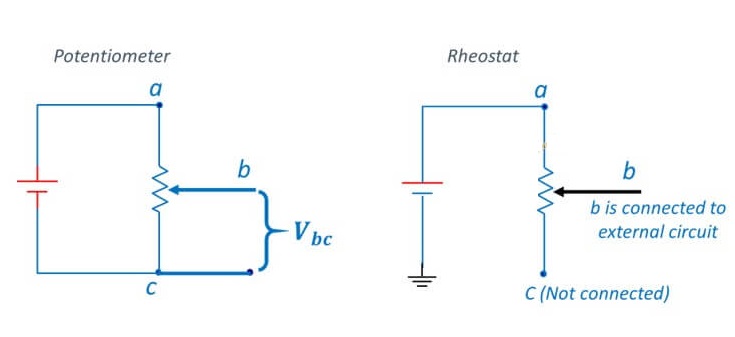
In this section, you can learn the essential difference between potentiometer and rheostat. But if you want to explore more about the difference between potentiometer and rheostat, visit here.
Description
A potentiometer is a type of resistors including three terminals with a sliding contact and an adjustable divider for regulating the voltage. While a rheostat is a special variable resistor including two terminals that creates a relation between one side and the wiper.
Use
A potentiometer is utilized as a measuring device or component in electronic applications. A rheostat is employed to change the resistance value of a circuit.
Makeup
A potentiometer is constructed from resistive components like graphite and resistance wire. Whereas a rheostat is manufactured of different materials such as metal films and carbon ribbons.
Function
A potentiometer is generally utilized in diagrams to change the voltage. A rheostat is commonly used in systems to control the current.
Main Function
The basic function of a potentiometer is voltage dividing. While the usual function of a rheostat is to determine the flow of current.
Voltage vs. Current
The potentiometer arrangement is used to supply the voltage in any system. While the rheostat is employed in a series configuration to specify the amount of current.
Application
A potentiometer uses low power and is employed for audio and TV controllers, or as a transducer. A rheostat is employed in high power industrial systems such as fans and mixers.
2 Terminal vs. 3 Terminals
All three terminals systems can be introduced as a potentiometer during POT functions. While the rheostat model uses one edged and one central terminal.
Connection
The potentiometer should be arranged in a parallel configuration with the system, while a rheostat makes a series connection in the circuit with other parts to control the flowing current.
Voltage Dividing
Rheostat cannot separate and control the voltage, whereas the potentiometer can be used as a voltage divider.
Flexibility
A potentiometer can be employed as a rheostat. But the rheostat cannot be utilized as the other one.
Potentiometer vs. Rheostat: Practical Applications
A potentiometer supplies variance in the amount of voltage at particular terminals and is used in power industries for monitoring the performance of DC motors. It also can be used in audio equipment for controlling the sound. The frequency setting on old radio setups utilizes a repeated process of both these types.
Key Difference Between Potentiometer and Rheostat
A potentiometer is a 3-terminal device whose ends are attached to the diagram with a specific wiper. However, a rheostat is a 2-terminal instrument that includes some connections between one end and the slider part.
A potentiometer determines the voltage value of any system. While a rheostat monitors the current flow in the circuits.
A potentiometer is principally included in the graphite. While rheostat is composed of metal ribbons or carbon components.
A potentiometer is introduced as a sensor, whereas a rheostat can be known just as a variable resistor.
A potentiometer is generally desirable for applications with low power. While a rheostat is commonly used in high power industries.
The potentiometer is set in the parallel arrangement within the system, while a rheostat is configured in serial connection which the current can be simply determined.
The next diagram presents a brief comparison to show the difference between potentiometer and rheostat.
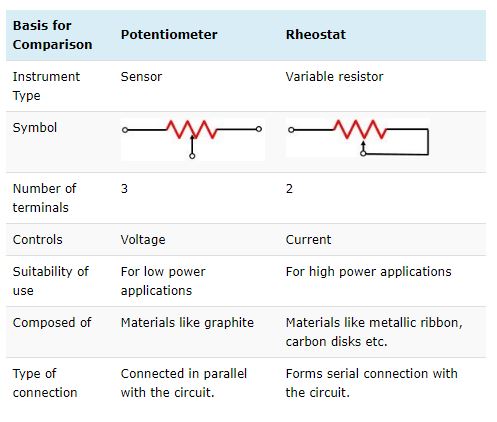
FAQs about Difference between Potentiometer and Rheostat
What is the advantage of rheostat over potentiometer?
Although any variable potentiometer can theoretically be set up to function as a rheostat, in practice rheostats are typically big, wire-wound variable resistors with high power ratings that are used in high-current applications.
What is the difference between potentiometer rheostat and variable resistor?
A potentiometer is what is used when a changeable resistor with three ends is used as a potential divider. It works as a variable resistance and is called a rheostat when there are only two ends.
Can you change the resistance of a potentiometer?
As you turn the knob on a potentiometer, the resistance can change either in a straight line or in a logarithmic way. The decline refers to how the resistance shifts. In a linear taper potentiometer, no matter where the dial is turned, a specific quantity of rotation will result in a specific change in resistance.
Can a rheostat adjust voltage?
Unlike a potentiometer, a rheostat doesn’t change the voltage right away. Instead, the voltage that is applied to the component and the circuit stays the same. A rheostat, on the other hand, alters current (and, consequently, voltage) by raising or lowering resistance.
Does a rheostat waste energy?
Both rheostats and potentiometers are bad ways to control the brightness of a lamp because the resistive parts of the switch waste some of the heat. As a result, they are rarely used in contemporary lighting setups.
Does temperature affect potentiometer?
The potentiometer wire’s resistance rises along with its temperature, affecting the potential gradient.
Conclusion
So, we can notice that while both rheostat and potentiometer are devices that monitor two different features including voltage and current, both of them employ the motion of slider to provide considerable variation in the quantity needed for their function.
Download Difference between Potentiometer and Rheostat PDF
You can download this article as a PDF so that you can access it whenever you like.
linquip.com-What is the Difference Between Potentiometer and Rheostat
Watch Videos about Difference between Potentiometer and Rheostat
For more information about Difference between Potentiometer and Rheostat, watch this video about Difference between Potentiometer and Rheostat.
Buy Equipment or Ask for a Service
By using Linquip RFQ Service, you can expect to receive quotations from various suppliers across multiple industries and regions.
Click Here to Request a Quotation From Suppliers and Service Providers
Read More In Linquip
- Potentiometer Connection, Working, Circuit
- Difference Between Voltmeter and Ammeter
- What is Potentiometer
- Difference Between Potentiometer and Voltmeter
- Ultimate Guide: What Is Linear Potentiometer
- What is Rotary Potentiometer? What It Does for Us
- What Is a Digital Potentiometer? An Explanation of the Working Principle and Advantages
- Potentiometer Connection, Working, Circuit Diagram, & Wiring Guide
- Types of Potentiometers: The Ultimate Guide to Learning About Different POT Types
- What Is CNC Machining & How Does It Work? (A Comprehensive Guide)
- What is Electrical Identification? (Ultimate Guide)
- What is the Core Difference between Thermistor and RTD?
- What is a Paper Capacitor?
- What is a Differential Pressure Sensor?: An Ultimate Guide
- What is Synchroscope? Method & Working Principles
- What is a Non-Polarized Capacitor? Definition & Usage
- What is Paper Capacitor Used for?
- What is Mica Capacitor Used for?
- What is an Electrolytic Capacitor? Usage & Application
- What is Film Capacitor & What is it used for?
- What is Capacitor and How Does it Works?
- What is the Core Difference between Thermistor and RTD?
- Difference Between Actuator and Sensor: The Ultimate Guide
- Difference Between Thermopile and Thermocouple
- Difference Between Condenser and Capacitor in a nutshell

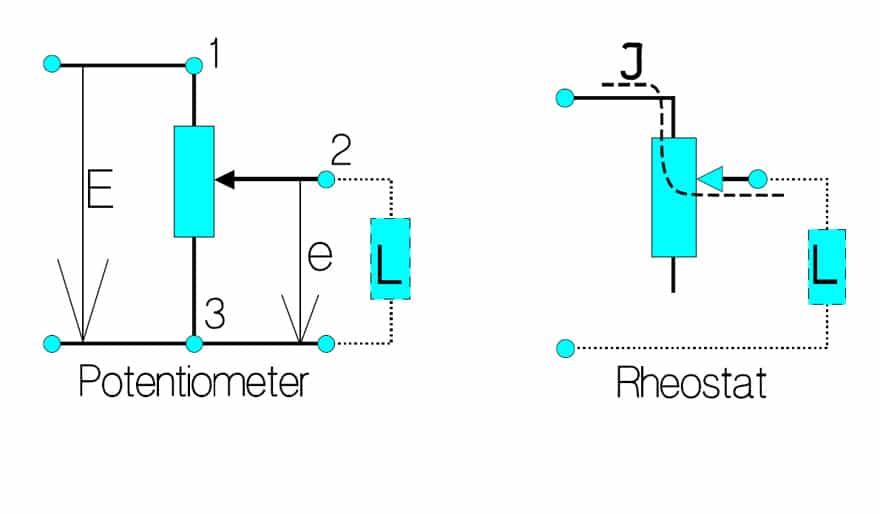


Kindly quote for the following items
1.CONTACTOR REVERSAL DC EMD FOR GM LOCOMOTIVE P/N:8328962
2.resistor 10000/15000 FOR GM LOCOMOTIVE P/N:8208221
3.AXLE ASSEMBLY 90TON GM LOCOMOTIVE P/N:J.1(B) DRAWING NUMBER:NK84/51889
4.WHEEL SOLID 40” FOR GM G18U LOCOMOTIVE P/N:WS-10082
5.SHAFT AXLE FOR 61 TON G18U GM LOCOMOTIVE DRAWING NUMBER:NK84/45878
6.AXLE WHEEL SHAFT DRAWING NUMBER:45878 FOR 61 TON GM G18U LOCOMOTIVE
7.CONTACTORS P12/P34 FOR GM LOCO P/N:8334912
8.SWITCH ROLLER FASTON FOR GM LOCO P/N:8296748
9.CONTACTORS BF P/N:8294080 FOR GM LOCO P/N:8294080
10.CONTACTORS FIELD SHUNT FOR GM LOCOMOTIVES P/N:8336625
11.REGULATOR LOAD COMPLETE WITH RHEOSTER FOR GM LOCOMOTIVE MODEL:GN28MC P/N:8371667
12.CONTACTORS SF FOR GM LOCOMOTIVE P/N:8254055
Please visit this page to know all you want.
https://www.linquip.com/blog/types-of-resistor-classification-application/
Don’t forget to share your comments.
Got it backwards. A potentiometer can be used as a rheostat, but a rheostat cannot be used as a potentiometer. Just don’t use one of the potentiometer terminals.
Thanks for leaving your comment, Nope! We also encourage you to visit the Linquip website, where you can find numerous industrial equipment, along with companies and experts.
Dear Sir/Madam,
I hope you are doing well. I want to request you to provide us with a quotation for the below mentioned quality items.
Additionally, could you please provide exact delivery time(stock condition), prices with in advanced discount and delivery based on CIP terms to Baku, Azerbaijan.
Regulating rheostat
Nominal welding current, A – 315
Resistance, Ohm: minimum – 0.095, maximum – 5,
Welding current adjustment limits -5-315 A
Nominal relative load duration PN% – 60,
The duration of the welding cycle is min – 5,
Adjustment of the difference between the currents of adjacent stages, A – 6,
Front dimensions, mm – 600x340x500, weight <25 kg
Standard GOST15150-69
24 EACH requested.
TDS and HS codes are required in advance.
Thanks for visiting our website. You can visit our Industrial Equipment page, where you can find various Regulating Rheostat based on your application and demand. You can also visit our expert page and take advice from hundreds of professionals on your issue.